We’ve previously looked at Warren Ellis’s realistic worldview, at his much-celebrated 1999-2003 period, and at his work for Marvel from 2004-2010.
One of the more interesting developments of Ellis’s career, especially given his professed distaste for the super-hero genre’s dominance of mainstream comics, has been his authoring of super-hero comics for Avatar Press, a publisher not known for super-hero work.
Ellis has done this even while continuing work in other genres for the same publisher. For example, Crécy (July 2007) is an excellent historical tale in which the protagonist breaks the fourth wall, and his words deconstruct readers’ romantic notions of both history and warfare. Doktor Sleepless (#1, July 2007) follows a mad-scientist figure; Ellis has himself compared it to Transmetropolitan in terms of genre and themes. Anna Mercury (#1-5, Mar-Dec 2008, followed by Anna Mercury 2 #1-3, May-Dec 2009) stars a red-headed, leather-clad who shifts between parallel worlds and uses advanced technology to keep weapons from falling into the hands of residents of more primitive worlds; one could argue it’s a super-hero series, but its tone seems to owe at least as much to science fiction. Aetheric Mechanics (Oct 2008) is set in a steampunk alternate history. Similarly, Ignition City (#1-5, Apr-Oct 2009) is also a retrofuturistic alternate history story; both are closer to Ellis’s other sci-fi work than his super-hero work. Frankenstein’s Womb (July 2009) offers a Gothic story and an exploration of artistic inspiration.
Few writers log such an impressive list of interesting work in different genres, but that’s even more rare for a comics writer. And of course, all of these works reflect, in one way or another, Ellis’s real-world concerns and his preference for grounding the fantastic or the science-fictional in the human. Even his more outré sci-fi concepts are rooted in theoretical physics and how they spur existential questions about human identity or the nature of reality.
But it’s Ellis’s super-hero work for Avatar, where he presumably has the creative freedom to write what he wants, that most clearly illustrates his revisionist tendencies.
Black Summer (#0-7, May 2007 – July 2008), illustrated by Juan Jose Ryp, tells a violent story of super-heroes operating in a real-world political environment. It begins, shockingly enough, with a super-hero executing the president of the United States and then explaining himself, unapologetically, on TV. The president is clearly a stand-in for George W. Bush.
 Revisionism has often pointed out that, while super-heroes oppose costumed villains, this only supports the status quo; despite all their rhetoric, super-heroes rarely use their powers to challenge social injustice or the powers-that-be. Ellis’s seminal Stormwatch storyline “Change or Die” (Vol. 1 #48-50, late May – July 1997) was entirely crafted around this dynamic, with the “heroes” opposing and finally killing the “villains” who, despite their excesses, only wanted to create a better world. Yet there could be no illusion that the corrupt government-affiliated organization, for which Stormwatch worked, was significantly purer than these apparent villains. These tensions would lead into Ellis’s The Authority, in which the team sought to take proactive action to make a finer world itself – yet still would up fighting villains, albeit increasingly larger-scale ones than normal.
Revisionism has often pointed out that, while super-heroes oppose costumed villains, this only supports the status quo; despite all their rhetoric, super-heroes rarely use their powers to challenge social injustice or the powers-that-be. Ellis’s seminal Stormwatch storyline “Change or Die” (Vol. 1 #48-50, late May – July 1997) was entirely crafted around this dynamic, with the “heroes” opposing and finally killing the “villains” who, despite their excesses, only wanted to create a better world. Yet there could be no illusion that the corrupt government-affiliated organization, for which Stormwatch worked, was significantly purer than these apparent villains. These tensions would lead into Ellis’s The Authority, in which the team sought to take proactive action to make a finer world itself – yet still would up fighting villains, albeit increasingly larger-scale ones than normal.
It was left to Mark Millar, Ellis’s hand-picked successor as The Authority’s writer, to fulfill the revisionist promise of what Ellis had teased and invoked. Millar’s team intervened in real-world political situations, drawing the ire of the world’s most powerful governments (including, at least before DC censorship, portrayals of real-world political figures like Bill Clinton and George W. Bush). Ultimately, those governments struck back by beating and replaced the team with its own amoral, corporate, market-tested version – before the original team returned.
Millar is the one remaining major super-hero writer, besides Ellis, still largely working in the revisionist mode, against the reconstructionist tide. And there was no small amount of irony in Ellis, having conceived of The Authority as his accommodation of the reconstructionist trend, only to have his chosen successor, Millar, hew much closer to Ellis’s own revisionist foundations and reap even greater sales. What Millar had accomplished was a braver, more aggressively political revisionist work than any other previously, including Ellis’s own.
Black Summer may best be understood as Ellis’s response. After all, what could be more aggressively political, in the revisionist mode, than opening with a super-hero murdering the then-sitting U.S. president?
As the series continues, the U.S. declares martial law and opposes the world’s few super-heroes. They turn on the president’s killer, who is himself killed in the conclusion – although the ending retains a strong amount of moral ambiguity. There’s no pretense that Bush wasn’t guilty of crimes, even if his summary execution – however motivated by good intentions – could not be allowed to stand.
No Hero (#0-7, June 2008 – Sept 2009), illustrated by Juan Jose Ryp, merges the super-hero genre with Ellis’s interest in alternate histories. Its heroes emerged in the 1960s as part of the counter-culture’s resistance to police brutality. Such alternate histories aren’t unknown in super-hero stories, especially those of the revisionist variety, but no super-hero writer had as much of a pedigree in writing alternate histories on their own. The story also isn’t without its own political overtones, while not as aggressively so as Black Summer.
More creatively successful was Supergod (#1-5, Oct 2009 – Oct 2010), illustrated by Garrie Gastonny. In essence, the story is another political take on the super-hero, only this time exploring the idea of an international super-hero arms race – an idea invoked frequently enough within super-hero comics, yet never very successfully imagined. But if Black Summer represents the political super-hero, Supergod may be said to represent the religious super-hero. This too has a long history within the genre, although usually confined to single stories in which a new character is shown to worship the protagonist. Super-heroes are often enough called “gods” and some stories (especially ones starring Superman) have benefited from Christological themes, emphasizing the hero’s sacrifice. But never before had a religious super-hero story been presented with as much fullness as Supergod.
Humanity has often interpreted the mysterious and the powerful in terms of deities, and it’s hard to imagine that super-heroes, operating in anything resembling the real world, wouldn’t be responded to along these lines, at least by some. This theme dovetails with the political one, in that the world’s governments style their own national messiahs according to their own cultural values, including in some cases their dominant religion’s gods.
 But neither super-heroes nor gods, at least in any remotely realistic work, stay within the limits of their government’s or their culture’s lines of acceptable behavior. If power corrupts, worship does too – and the processes that might create a super-hero might also deform a being’s psychology or mental capabilities. Like many revisionist works, Supergod doesn’t pretend that the presence of super-heroes wouldn’t deform history. In fact, their powers are likely to cause massive casualties. Supergod takes this to its logical conclusion, presenting an Earth that has become a plaything for real and warring gods – and is devastated as a result.
But neither super-heroes nor gods, at least in any remotely realistic work, stay within the limits of their government’s or their culture’s lines of acceptable behavior. If power corrupts, worship does too – and the processes that might create a super-hero might also deform a being’s psychology or mental capabilities. Like many revisionist works, Supergod doesn’t pretend that the presence of super-heroes wouldn’t deform history. In fact, their powers are likely to cause massive casualties. Supergod takes this to its logical conclusion, presenting an Earth that has become a plaything for real and warring gods – and is devastated as a result.
Adding to the story’s literary sophistication, the story is framed by a sequence taking place after the planet has been devastated, and the bulk of the story thus consists of flashbacks that walk readers through the development of various national super-heroes, letting readers understand the massive global changes that would inevitably result, were super-heroes actually real.
While works like Supergod haven’t gotten the attention of works like Ultimate Fantastic Four or Thunderbolts, they’re far less compromised. And with such restrictions removed, Ellis’s super-hero works tend to embrace realism to a far greater degree, in some cases producing major revisionist works.
Postscript: Grant Morrison’s Supergods
In July 2011, less than a year after Ellis’s Supergod concluded, Grant Morrison released a non-fiction book entitled Supergods: Our World in the Age of the Superhero. It’s a retelling of super-hero history through Morrison’s eyes, unabashedly praising the super-hero and the powers of human imagination that the super-hero represents. Morrison also draws the comparison between super-heroes and gods, although this is for him a positive association. Both, to Morrison, are ideas – and at best, wondrous ideas that both express human aspirations and can spur us to reach for our better selves.
It’s a beautiful idea – one certainly not without merit. And it’s hard not to be inspired by Morrison’s optimism and his desire to reject cynicism.
That said, a clearer contrast with Ellis’s Supergod could scarcely be imagined. Of course, one work is fiction in the comic-book format, while the other is non-fiction in prose. They’re hardly of equal length: Morrison’s Supergods is much longer, even without counting how less is generally accomplished on a page of comics than on a page of prose. Still, both are statements – manifestos, even – on the super-hero genre.
In Ellis’s Supergod, the worship of super-heroes is a problem. It stems from the same thing within the human brain, filtered through culture, that once worshipped kings as living gods and thought stars were deities en route through the sky. These ideas, while charming or beautiful, are manifestly untrue. They may be used to manipulate humans to be better, but they do so through deception, or at least belief in something that is not, after all, real. Of course, this same power can be used for ill – there’s nothing about it that’s intrinsically positive. This is the true power of gods, or of what (like super-heroes) we make into our gods, and it is impartial.
Such belief may not be counter-evolutionary, as Ellis has said about the wish that Superman might have prevented 9/11. But such belief certainly is anti-democratic. Democracy isn’t rooted simply in the observation that people, in aggregates, tend to make better choices than even intelligent and informed single individuals, who are easily swayed by their biases. Democracy is also predicated upon the observation that tyranny, while it might theoretically be benevolent and wise, can also be catastrophically malevolent or foolish – to such a degree that it can destroy a society. And that’s where Supergod leaves us.
The problem Ellis has with super-heroes, as he articulates it, isn’t with the genre per se. It’s with the way it’s worshipped, within the American comics-reading community.
At the heart of the super-hero, for Morrison, is the super-hero’s goodness and the imagination it represents. No one, probably, is utterly immune to such appeals. But at the heart of the super-hero, for Ellis, is power and its worship. And the super-hero genre may be seen as an examination of power and the responsible exercise thereof. If the super-hero is wonderfully imaginative, it’s imaginative because it’s not real. The super-hero’s goodness, or lack thereof, is equally fictive. Actual goodness, as we see in works like The Authority or Black Summer, is always fraught with uncertainty and ambiguity. To determine such goodness, whether in a super-hero or a religion or a political leader, involves examination and thought, not simply marveling at power, costuming, and names.
To examine the fantastic isn’t to reduce it – except to those who don’t want their faith punctured and fear that it might be. (If one has no such fear, why object?) Ellis isn’t a realist who eschews the fantastic – virtually all of his works involve some element of the fantastic, and it’s hard not to see a love of such elements in his oeuvre. But Ellis isn’t afraid to examine them, and the real is the only spotlight that doesn’t blind.





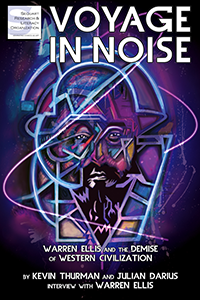



























































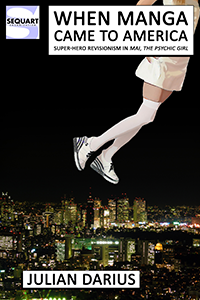
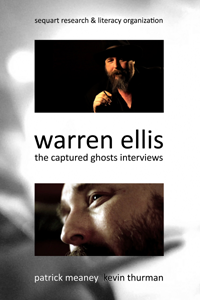
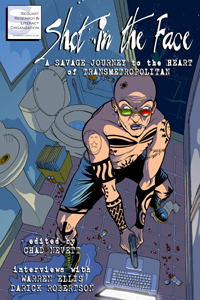


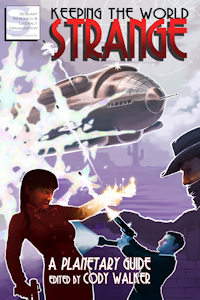




Hey Julian, I have been reading Sequeart for a while now (started from the first page about aonth ago and have been reading almost any article that really interests me since that page) and I just really want to thank you from the bottom of my heart (why the bottom anyways?) for this site
More to the point though thanks to this series I definitely will check out Ellis in some considerable depth. I mean I think reading Ellis in some way or another was probably inevitable for me due to wanting to read Tranepolitan and The Authority but now I want to read way more than that.
I don’t know if this was the last part or retroactively the Ellis post with the Ultimate FF was made to be but either way it has convinced me of Ellis’ importance so thanks for that.
Thanks, Nick! Great words of encouragement! I really, really appreciate it.
I think I retroactively added the FF post to this, as a kind of appendix.
(Both essays, by the way, are included in Voyage in Noise, the book on Warren Ellis that Kevin Thurman and I co-wrote. If you’re interested; I know money’s tight.)
Again, thank you so very much, Nick! Let me know what you think of diving into Ellis’s work!
I am glad my words encouraged you and that you appreciated them because this is a great site and I hope it continues for a long time to come. :)
Ah, it was retroactive, I figured.
Oh, they are? That makes sense. Yeah, money is tight for me these days probably like most people but a few of Sequart’s books are of big interest to me (for instance your book on Batman Begins and The Killing Joke as well as the one on Revisionism you wrote plus the Minutes to Midnight one) so eventually I would love to support you guys like that. Maybe for Christmas if I don’t fill up my list with a bunch of trades. ;)
Cool, I shall. Any recommended starting points for reading Elllis?
Thanks so much for your response, Julian! :)